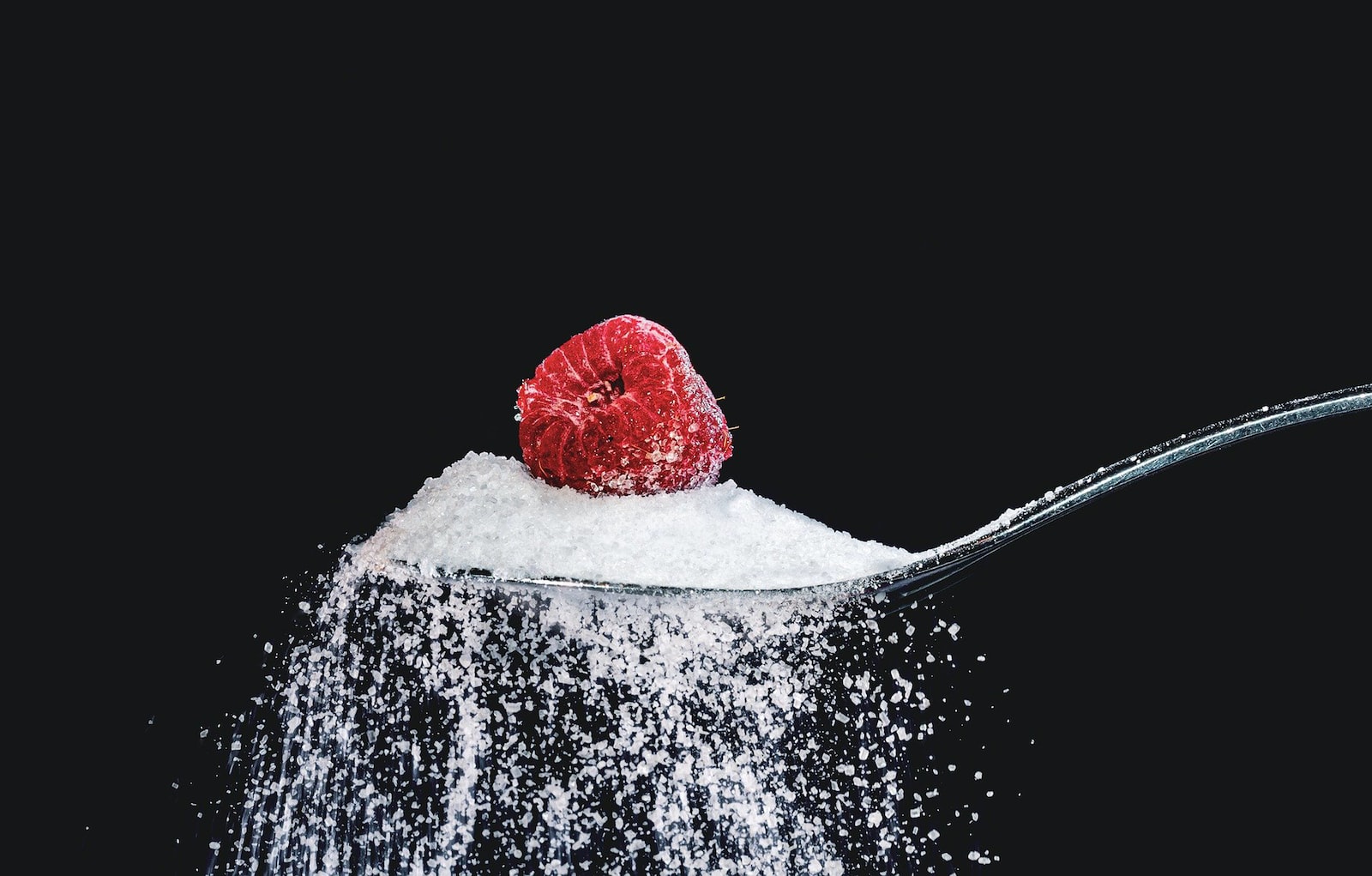If you have been listening to mainstream media, you probably are convinced that sugar is the devil incarnate when it comes to healthy eating and weight loss. Yes, sugar is delicious and tempting and even comforting. But eating too much can lead to all kinds of problems – including weight gain and obesity, . And most Americans eat way, way too much. (up to 5 times the recommended amount by the American Heart Association).
Sugar is also really sneaky. It is EVERYWHERE…in places you don’t even suspect. So when you are at a conference and innocently picking up that cup of yogurt at breakfast, thinking you are being “good”, you are likely just inhaling a bunch of sugar. You might as well have had that danish! Even when it comes to less obvious “evils”, there are so many conflicting opinions. Fruit is good. No, fruit’s just like sugar, it’s bad. White sugar is bad, but honey and date syrup are legit “clean eating.” Or the “sugar is sugar is sugar” trope.
It all comes back to being smart, not being dogmatic. In this article, I boil down what you need to know to be smart about sugar. Most of the reason we overconsume is lack of information and marketing hacks. This article will give you the knowledge you need, so you don’t have to deprive yourself.
Sugars come in all chemical shapes and sizes
Does anyone remember organic chemistry? The chemical formula for sugar is C12H22O11.
The reason this formula is important is because it means that “sugar” is really a simple molecule composed of glucose and fructose. ALL carbohydrates are composed of these two guys, some are just more complex molecules. Here is a simple list illustrating the basic sugar categories:
- MONOSACCHARIDES (one-molecule sugars) Glucose Fructose (levulose or fruit sugar) Galactose (occurs in milk)
- DISACCHARIDES (two monosaccharides linked together)
- Sucrose (table sugar) = glucose + fructose
- Lactose (milk sugar) = glucose + galactose
- Maltose (malt sugar) = glucose + glucose
- POLYSACCHARIDES (more than 10 monosaccharides linked together) Starch (glucose polymer)
Basically, all carbohydrates, including fruits, vegetables, grains, and cookies, are broken down into glucose and fructose, which are two of the three simple sugars used by our bodies – the other one is galactose, which is found in dairy products. Sugars are also found in smaller amounts in other foods – like vegetables and nuts (which is why cashews can blow you out of keto).


So are candy and broccoli one and the same in the sugar lens?
So based on these facts so far, you might be thinking, I could eat a milky way bar or broccoli – it doesn’t matter. Well, not exactly. While all sugars end up at the same “glucose” destination, they are metabolized differently. Think about it like a cross-country flight versus having a layover. The ultimate destination are your various organs, muscles, and tissues – which include fatty tissues.
Foods containing simple added sugars, like juices, sodas, candy and white flour foods, get to your destination faster. They are more quickly broken down into glucose and released into the bloodstream. This triggers the release of insulin from the pancreas so glucose can move inside the cells and be used. Any excess glucose not used is either stored in the muscles or in fat cells. Hence the trope of “sugar is stored as fat”.
So what are added sugars then?
These added sugars have all kinds of different names that you need to be aware of when reading labels:
- Brown sugar.
- Corn sweetener.
- Corn syrup.
- Fruit juice concentrates.
- High-fructose corn syrup.
- Honey.
- Invert sugar.
- Malt sugar.

These sugars may be found in foods you may not suspect have added sugar, like yogurt, cereals, health drinks, protein shakes, and salad dressings (especially the “low fat” kinds -because the lack of fat is made up for by adding more sugar).
So follow my advice in this post – ALWAYS read the label. Even something as innocuous like yogurt with fruit “on the bottom” is really often yogurt with sugary syrup on the bottom.
Many of the fruit flavor related sugars contain high-fructose corn syrup. High-fructose corn syrup is essentially a a processed sugar using fructose. While fructose is also in regular fruit, the higher concentration in HFCS can lead to more health issues.
But Honey?
What about honey, agave, date and maple syrup? The clean-eating world deifies these as “good for you” sugars, but critics say these are all the same to your body as white sugar. On the other hand, honey, for example, has a lower glycemic index, i.e., it doesn’t affect your blood-sugar levels as much). It also contains more vitamins, minerals, and antioxidants, such as calcium, potassium, vitamin C, zinc, phenolic acids, and flavonoids. So while these may be starring ingredients in organic, “non-GMO” foods, beware that they do contain sugar.

OK – so is sugar bad or not?
We need glucose to survive. Even if you stop eating carbs, your body finds ways to break down fats and proteins into enough glucose to keep you alive. Because of this fact, technically, our bodies don’t NEED any carbohydrates from added sugar. Barring any medical complications, this doss not mean we should never consume added sugar in any form, especially if weight management is the main goal.
While added sugar is not “needed” – it is also not inherently harmful, in reasonable quantities. So what IS a reasonable, recommended quantity?
It is a question of quantity. A moderate amount of sugar, even added sugar, can be part of an overall healthy diet. The Dietary Guidelines for Americans 2020-2025 advise that all Americans 2 years and older limit added sugars in the diet to less than 10% of total calories. For a 2,000 calorie/day diet, that translates into 200 calories or 50 grams of sugar daily (about 12 teaspoons of sugar). Toddlers and infants younger than 2 years should not be given solids or beverages with any added sugars. The American Heart Association (AHA) The AHA suggests a stricter added-sugar limit of no more than 100 calories per day (about 6 teaspoons or 24 grams) for most adult women and no more than 150 calories per day (about 9 teaspoons or 36 grams of sugar) for most men.
As a visual, 4 grams of sugar is equal to a teaspoon.

Sugar can be useful for quick workout fuel…
Sugar is a fast-digesting carbohydrate. Fast digesting carbohydrates can have their time and place, especially when it comes to workouts.
The best times to have fast-digesting carbohydrates are before and after a workout. When you work out, your muscles’ main source of energy is glycogen (the form of glucose stored in your body’s tissues). Working out depletes your body of glycogen. This is noteworthy because glycogen is key for muscle growth and maintenance. By consuming a meal high in fast digesting carbohydrates before and after a workout, you ensure your muscles’ supply of glycogen is maintained, while also providing yourself with an important energy boost. Additionally, eating fast-digesting carbs first thing in the morning can be beneficial for preventing muscle breakdown and managing hormone levels.

…But Sugar might age you
Diets high in sugar can increase wrinkles and sagging. Research has shown that advanced glycation end products (AGEs), a class of compounds resulting from combinations of sugars and proteins, can accelerate the effects of aging. These form whenever blood sugar is high, mostly from overconsumption of quick-digesting carbohydrates, including sweeteners and refined starches.

Photo by Mateusz Feliksik @ Unsplash
What about fruit?
While many diets like keto vilify fruit as just another source of carbs and sugar the fact that most fruit is so low in calories AND contains valuable nutrients as well as cancer-fighting antioxidants make it a good source of natural sugar.
Think of it this way: a glass of fresh-squeezed orange juice is equal to about THREE large oranges, but think of how you would feel if you ate one orange after another in the time it would take you to drink the juice. Chances are you would feel as though your stomach would explode – and WHY? Because of the fiber in fruit. The fiver in the fruit is what slows down the absorption of sugar and also contributes to your daily need for fiber (about 25 grams for women, 35 grams for men)
The Takeaway
There is a place for sugar in a healthy diet – even one aimed at losing weight. Having a small treat every day, or a piece of cake at a party will not derail you. The key is your mindset – instead of thinking you CAN’T have sugar, think of it is as your choice, and choose instead to eat mostly whole foods and naturally sweet foods like fruits.
Research resources
- https://legionathletics.com/sugar-facts/#the-truth-about-good-and-bad-sugars
- https://www.houstonmethodist.org/blog/articles/2020/sep/is-added-sugar-bad-for-you/#:~:text=Let’s%20start%20by%20addressing%20the,or%20dairy%2C%22%20explains%20Sessions.
- https://blog.myfitnesspal.com/ask-dietitian-can-you-survive-without-carbs/
- https://www.healthline.com/health/food-nutrition/sugar-facts-scientific#2.-Minimally-processed-or-natural-sugars-are-better-for-you.
- https://www.realsimple.com/health/nutrition-diet/healthy-eating/honey-maple-syrup-better-sugar#:~:text=Honey%20Health%20Benefits&text=%22Honey’s%20advantages%20over%20sugar%20include,phenolic%20acids%2C%20and%20flavonoids.%22
- https://sugarscience.ucsf.edu/sugar-metabolism.html#.Y9Q3BnbMJD9
- https://www.sugar.org/sugar/what-is-sugar/
- https://www.niddk.nih.gov/news/archive/2017/tale-two-sugars-fructose-glucose-cause-differing-metabolic-effects#:~:text=Most%20food%20and%20beverages%20are,metabolizes%20fructose%20and%20glucose%20differently.






